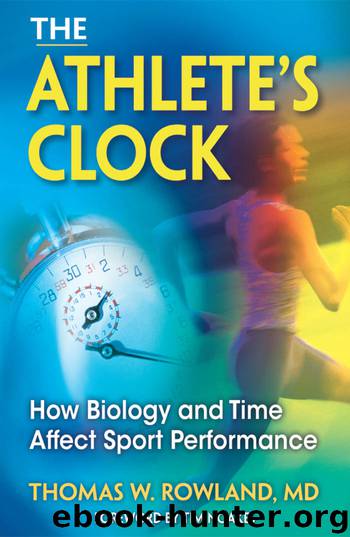The Athlete's Clock by Thomas Rowland

Author:Thomas Rowland
Language: eng
Format: epub
ISBN: 9781450411059
Publisher: Human Kinetics
Forecasting From the Past
When people have plotted winning Olympic times for the 100-meter sprint against dates, they show what looks like a straight line of improvement throughout the years. That is, they report a linear relationship between year and gold-medal times. In the last century, this has amounted to a full second of improvement in 100-meter sprinting times for men. When these findings are compared between men and women, things get interesting. The slope of the line, or the rate of improvement, is greater for females than for males. In fact, Andrew Tatum and his research group in the United Kingdom predicted the two lines would intersect in the year 2156. After that, based on their projections, women would run the 100 meters faster than men. “Only time will tell,” they conclude, “whether in the 66th Olympiad, the fastest human on the planet will be female.”12 (Whether this will actually occur, of course, no one knows. But, here’s a clue. Based on a similar analysis of marathon performance by sex, it was once predicted that women would outrun men in the marathon by the year 1998.)
Alan Nevill and Greg Whyte, another pair of British investigators, claimed such analysis suffered from methodological pitfalls. With polite restraint, they pointed out that the linear modeling of trace performance cannot be correct, since it implied no ultimate limit of sprinting times. Moreover, it led to the obvious conclusion that sprinting performances would eventually result in negative world-record times. That would mean that the sprinter would finish the 100 meters a certain time before the starter’s gun sounded.12
These authors suggested that, instead, performance records plotted as velocity versus date actually followed a flattened, S-shaped curve. By this analysis, they said, there are limits to sprint performance, represented as the asymptote of this curve. They thought, too, that the greater improvement in women’s records reflected the fact that the more recent participation by females placed them on the accelerated portion of the curve.
Thinking about this, it seems obvious that there must be a limit, an absolute time below which no human will ever be able to run 100 meters. Here’s the argument. Would you accept that a 100-meter record will never be less than, say, 4.0 seconds? Sure. Okay, how about 9.0 seconds? No, it’s not unreasonable that someday that barrier will be broken. The conclusion, then, is that somewhere between 4 and 9 seconds is a certain absolute limit that will never, ever be broken.
Having settled that an ultimate limit for the 100 meters exists doesn’t mean, though, that humans might not continue to improve 100-meter sprinting performance. If a runner has an accurate enough clock and the willingness to add decimal points, performance can continue to improve, even if an absolute lower limit exists. Let’s just say that no man or woman will ever run a 100-meter sprint in 8.0 seconds. But, in successive Olympic competitions, gold medal times could be 8.01, then 8.009, then 8.0009, ad infinitum.
None other than Andy Warhol made note of this.
Download
This site does not store any files on its server. We only index and link to content provided by other sites. Please contact the content providers to delete copyright contents if any and email us, we'll remove relevant links or contents immediately.
Born to Run: by Christopher McDougall(6893)
Bodyweight Strength Training Anatomy by Bret Contreras(4464)
Dynamic Alignment Through Imagery by Eric Franklin(3919)
Men's Health Best by Men's Health Magazine(2388)
The Coregasm Workout by Debby Herbenick(2127)
Starting Strength by Rippetoe Mark(2013)
Relentless by Tim S Grover(1997)
Bigger Faster Stronger by Greg Shepard(1897)
Endure by Alex Hutchinson(1869)
Core Performance Essentials by Mark Verstegen(1857)
Weight Training by Thomas Baechle(1674)
Relentless: From Good to Great to Unstoppable by Tim S Grover(1590)
The Stretching Bible by Lexie Williamson(1501)
Practical Programming for Strength Training by Mark Rippetoe & Andy Baker(1466)
The Spartan Way by Joe De Sena(1432)
Good to Go by Christie Aschwanden(1388)
Dr. Jordan Metzl's Running Strong by Jordan Metzl(1330)
The Art of Throwing by Amante P. Marinas Sr(1303)
Total Hockey Training by Sean Skahan(1283)
